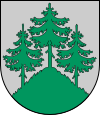Tukums
| Tukums | |||
|---|---|---|---|
| Town | |||

Lutheran church in Tukums
|
|||
|
|||
| Location in Latvia | |||
| Coordinates: 56°58′N 23°09′E / 56.967°N 23.150°ECoordinates: 56°58′N 23°09′E / 56.967°N 23.150°E | |||
| Country |
|
||
| District | Tukums municipality | ||
| Town rights | 1795 | ||
| Population | |||
| • Total | 19,722 | ||
| Time zone | EET (UTC+2) | ||
| • Summer (DST) | EEST (UTC+3) | ||
| Postal code | Lv310(1–2); LV-3104 | ||
| Calling code | +371 631 | ||
Tukums (![]() pronunciation ; German: Tuckum; Livonian: Tukāmō) is a town in Latvia. Three regions of Latvia meet in the vicinity of Tukums – Vidzeme, Zemgale and Courland.
pronunciation ; German: Tuckum; Livonian: Tukāmō) is a town in Latvia. Three regions of Latvia meet in the vicinity of Tukums – Vidzeme, Zemgale and Courland.
The historical center of Tukums developed between trade routes leading from the mouth of the Daugava River to Prussia. The oldest part is today's Talsi Street that originated at the river named Zvirgzdupite where there used to be a castle mound with a wooden castle. Since 1253 Tukums was ruled by the Livonian Order. A masonry castle was built on the bank of the Slocene river in the end of the 13th century. The castle was surrounded by settlements of German tradesmen and craftsmen. A marketplace was formed in front of the castle and some new streets appeared later running in various directions from the market place.
With the development of trade in the 16th century a new straighter trade route to Prussia was built along a new street that is called Liela (large) Street today. This street had an important role in the life of the settlement. Public buildings, major business, workshops and shops were concentrated in it.
After the disintegration of the Livonian Order a new state, the Duchy of Courland and Semigallia was established. Like many other settlements Tukums had suffered greatly the numerous feudal wars. Under the rule of Duke Jacob (1642–1682) Tukums experienced a rapid economic boom. At the time a new trade route from Tukums to Jelgava, the capital of Duchy of Courland and Semigallia, was opened along today's Jelgavas Street, and another route was made along today's Raudas Street towards it. A dam was built and a lake made near the road to Jelgava. A flour mill and a cooper furnace started functioning there, and cooper was exported to foreign countries. The town, inhabited by only 800 people was quite small. The new adornment of Tukums was the lake. The church spire was another landmark added to the skyline in 1687.
...
Wikipedia



